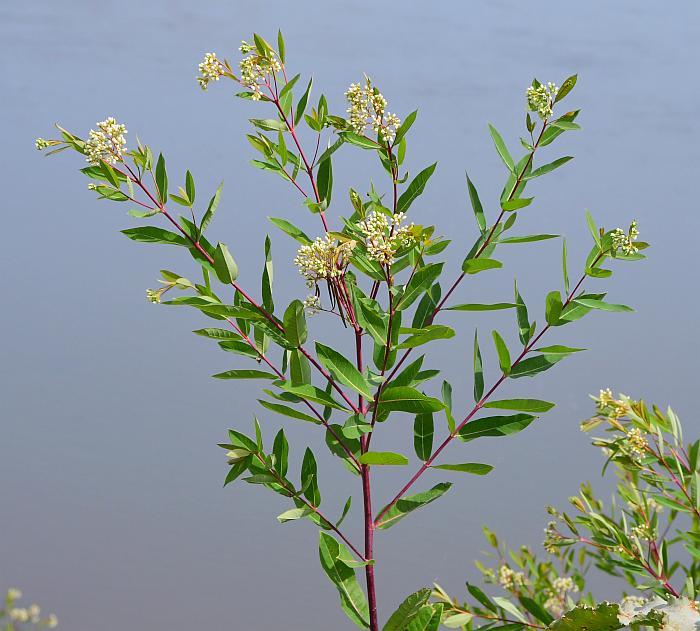Apocynum cannabinum L.
Prairie Dogbane

Native
CC = 3
CW = 3
MOC = 97
© SRTurner
Apocynum cannabinum L.Prairie Dogbane | |
 |
Native CC = 3 CW = 3 MOC = 97 |
© SRTurner |
|
Family - Apocynaceae Habit - Rhizomatous perennial herb, sometimes woody at base, with milky sap. Stems - Erect, to 1 m, glabrous below, pubescent above, glaucous, often reddish, branching above, single from base.
Leaves - Opposite, occasionally some subopposite or alternate, short-petiolate or sessile, mostly ascending to spreading, the petioles of the upper and sometimes median leaves 5-7 mm long. Leaf blades 1.5-14.0 cm long, 0.5-8.0 cm wide, lanceolate to broadly ovate or elliptic, rounded or shallowly cordate at the base, sharply pointed, glabrous or hairy, the undersurface pale green. Inflorescence - Terminal or axillary, branched loose clusters of few to many flowers. Flowers sweetly fragrant. Pedicels short, to 3 mm long. Flowers each subtended by a small lanceolate bract to 2 mm long.
Flowers - Calyces 5-lobed, glabrous, the lobes 1.5-2.5 mm long. Corollas 5-lobed, 2-5 mm long, narrowly bell-shaped to urnshaped, white to pale greenish, the tube 1.5-2.5 mm long, about as long as the calyx, 1.5-2.0 mm wide at the tip, the lobes 1.5-2.0 mm long, erect. Filaments 0.2-0.4 mm long, hairy. Stamens 5, incurved to form a cone over the stigma. Nectar glands 5, alternating with the stamens. Styles very short, the stigma more or less ovoid, encircled by a narrow thickening or rim around the midpoint. Ovary of two carpels. Placentation parietal.
Fruits - Follicles to 20 cm long, spreading or pendent, typically slightly curved. Seeds with the body 3-5 mm long, with the apical tuft of hairs 8-30 mm long.
Flowering - June - August. Habitat - Forests, savannas, swamp margins, prairies, pastures, disturbed sites, wooded slopes, roadsides, railroads. Origin - Native to the U.S. Other info. - This species can be found throughout Missouri and the entire U.S., and is quite common. It can be identified in the field by its reddish stems, milky sap, opposite leaves, and small white flowers. It could be confused with the other Missouri member of the genus, A. androsaemifolium, but the latter species has larger flowers with recurved corolla lobes and internal pink stripes. In some cases intermediate forms can be found which result from crossing of the two species. Photographs taken at the Kansas City Zoo, 6-11-00, and in St. Louis, MO., 7-28-03 (DETenaglia); also at Marais Temps Clair Conservation Area, St. Charles County, MO, 7-19-2010, Shaw Nature Reserve, Franklin County, MO, 12-22-2018, and Riverfront Park, Washington, Franklin County, MO, 5-27-2020 and 6-14-2023 (SRTurner) |